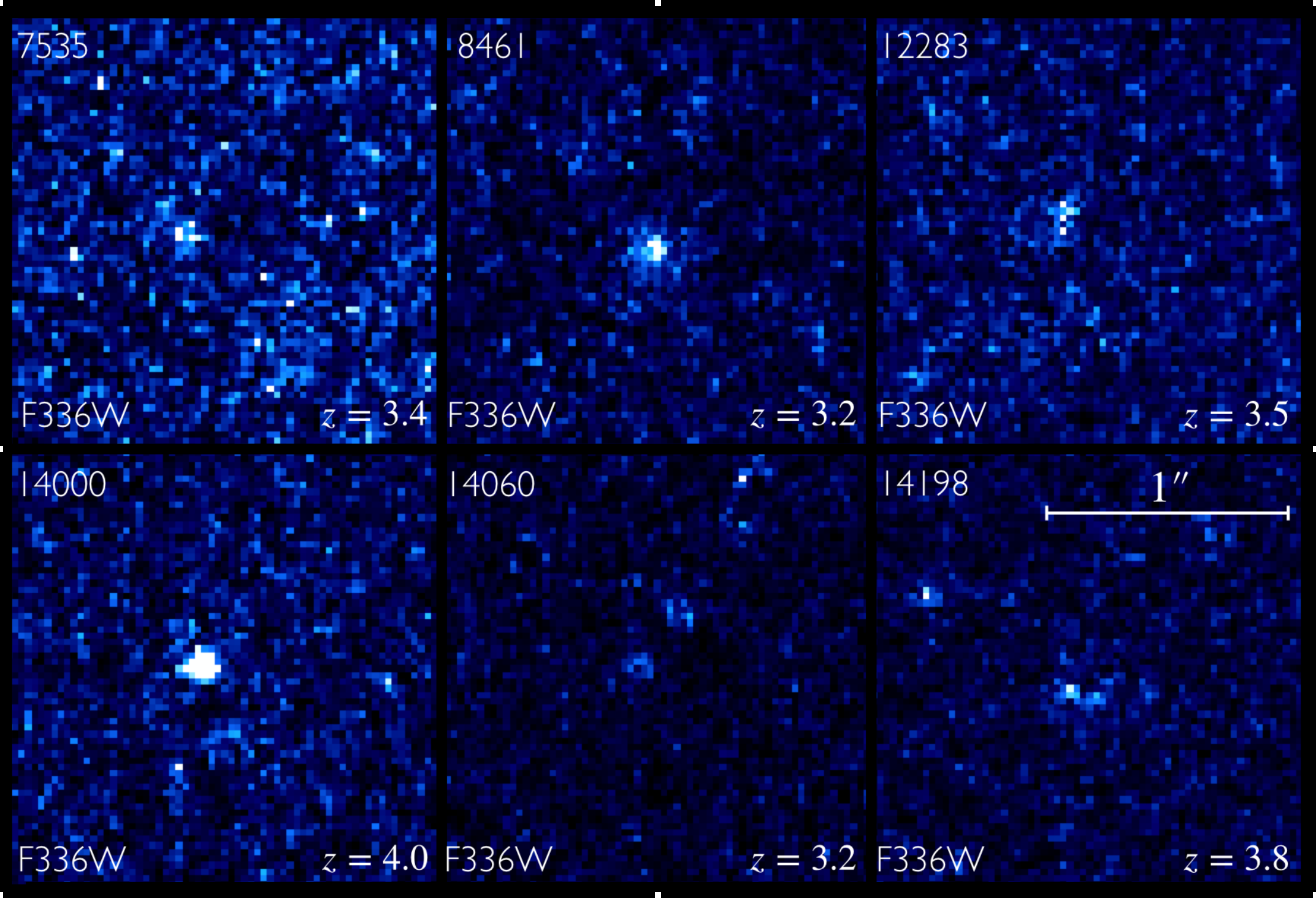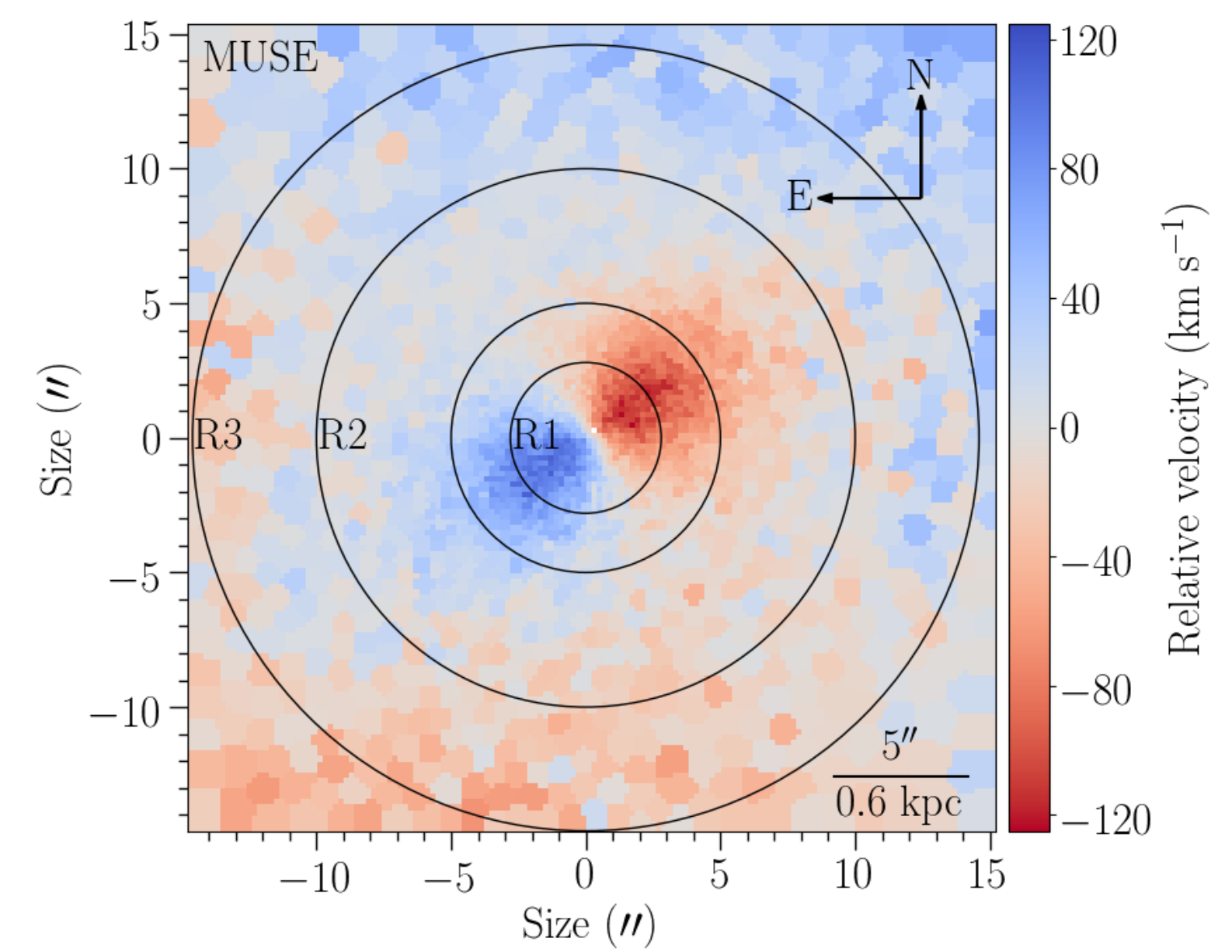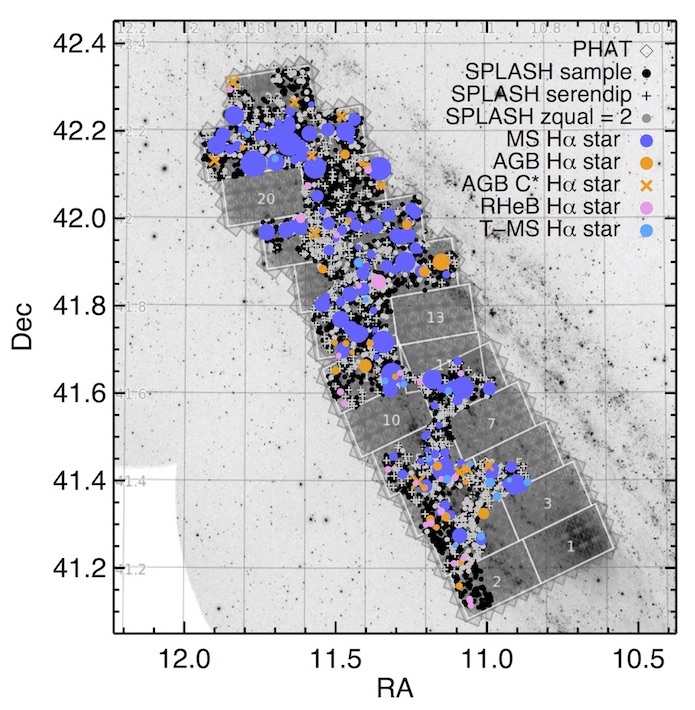Research
During my astrophysics career, I studied the evolution of galaxies across the lifetime of the Universe. Overviews of the key areas I researched are below and my publications can be found here.
- Lyman Continuum Galaxies
- The KMOS Cluster Survey (KCS)
- Unravelling the Origin of IC 1459's Counter-Rotating Core
- Emission-line Stars in the Andromeda Galaxy
Lyman Continuum Galaxies
 The Universe went from being entirely neutral to almost completely ionized during the Epoch of Reionization in the first billion years of its life (z < 6). The main contributors to the ionizing ultraviolet (UV) flux during reionization are likely to be young star-forming galaxies. Neutral gas in the Universe was so dense at z > 5 that we are unable to observe cosmic reionization directly, but instead look to galaxies close in time and properties to understand this critical period of the Universe's past. My past research focused on the identification of this rare population of very distant galaxies that emit this ionizing UV flux that we term Lyman continuum (LyC), as it is emitted below the Lyman break (<912 Angstroms). I used high-resolution UV imaging from the Hubble Space Telescope (HST) and 30-band photometric redshifts from the ZFOURGE survey to identify Lyman continuum galaxy (LCG) candidates, and ground-based spectroscopy from the Keck Observatory on Mauna Kea in Hawaii, to confirm the targets. (Image: LCG candidates in the HST UV images from Prichard et al. 2021).
The Universe went from being entirely neutral to almost completely ionized during the Epoch of Reionization in the first billion years of its life (z < 6). The main contributors to the ionizing ultraviolet (UV) flux during reionization are likely to be young star-forming galaxies. Neutral gas in the Universe was so dense at z > 5 that we are unable to observe cosmic reionization directly, but instead look to galaxies close in time and properties to understand this critical period of the Universe's past. My past research focused on the identification of this rare population of very distant galaxies that emit this ionizing UV flux that we term Lyman continuum (LyC), as it is emitted below the Lyman break (<912 Angstroms). I used high-resolution UV imaging from the Hubble Space Telescope (HST) and 30-band photometric redshifts from the ZFOURGE survey to identify Lyman continuum galaxy (LCG) candidates, and ground-based spectroscopy from the Keck Observatory on Mauna Kea in Hawaii, to confirm the targets. (Image: LCG candidates in the HST UV images from Prichard et al. 2021).
This work required the cleanest possible data to extract as much information as possible. I therefore made several improvements to the HST Wide Field Camera 3 (WFC3)/UVIS darks pipeline, all of which were adopted by STScI for future delivered data products. This custom WFC3/UVIS reduction pipeline is available on my GitHub. My 2020 talk on this research from the SAZERAC conference can be found here.
The KMOS Cluster Survey
During my PhD, I worked as part of the K-band Multi-Object Spectrograph (KMOS) guaranteed observing program, the KMOS Cluster Survey (KCS; P.I.s Bender & Davies). KMOS is an integral field unit (IFU) on the Very Large Telescope (VLT) in Chile. IFUs offer a 3D view of a galaxy, where each spatial pixel contains a full spectrum of light, and KMOS has 24 IFUs, each on a robotic arm. The aim of KCS was to study the evolution of galaxies in dense environments i.e. clusters of galaxies, between redshifts 1 < z < 2. To study the properties of the galaxies, we obtained deep absorption-line spectra, observing individual cluster galaxies for over 20 hours. These spectra, when combined with Hubble Space Telescope (HST) images, then enabled us to derive the kinematics, masses, and ages of the stellar populations in the galaxies (Chan et al. 2016, 2018, Beifiori et al. 2017, Prichard et al. 2017b). (Images: Four clusters from the KCS sample spanning 1.39 < z < 1.80, with names, redshifts, and sources shown.)
I focused on the highest redshift cluster in the sample, JKCS 041 at z = 1.80. In Prichard et al. 2017b, we presented the most detailed study of a high-redshift cluster performed to date. We investigated the properties of the galaxies and the dynamics of JKCS 041 to understand its galaxy and cluster formation. We discovered a younger in-falling population of galaxies, which links the ages of galaxies to large-scale structure of the cosmic web for the first time at this redshift. The study provides significant insights into galaxy and cluster formation at early cosmological times.
Unravelling the Origin of IC 1459's Counter-Rotating Core
 To understand how a galaxy has evolved, you can study nearby systems in detail to measure their 'fossil records'. Elliptical, or early-type, galaxies are ideal for this as they are old systems with very little dust and gas so you can easily probe their stellar light and properties. In Prichard et al. 2019, I worked with KMOS data in the little utilised mosaic mode and a large optical cube from the Multi Unit Spectroscopic Explorer (MUSE) instrument on the VLT to study a bright, local elliptical galaxy, IC 1459 to unravel its evolutionary history. This galaxy is a famous example of one with a counter-rotating core (Franx & Illingworth 1988); the stars in the inner part of the galaxy are rapidly counter rotating to the stars and ionized gas in the outer region. This interesting system is therefore an ideal laboratory in which to measure the stellar properties accross its kinematically distinct components, and to understand its formation history. (Image: Kinematics of the counter-rotating core in IC 1459 from MUSE from Prichard et al. 2019.)
To understand how a galaxy has evolved, you can study nearby systems in detail to measure their 'fossil records'. Elliptical, or early-type, galaxies are ideal for this as they are old systems with very little dust and gas so you can easily probe their stellar light and properties. In Prichard et al. 2019, I worked with KMOS data in the little utilised mosaic mode and a large optical cube from the Multi Unit Spectroscopic Explorer (MUSE) instrument on the VLT to study a bright, local elliptical galaxy, IC 1459 to unravel its evolutionary history. This galaxy is a famous example of one with a counter-rotating core (Franx & Illingworth 1988); the stars in the inner part of the galaxy are rapidly counter rotating to the stars and ionized gas in the outer region. This interesting system is therefore an ideal laboratory in which to measure the stellar properties accross its kinematically distinct components, and to understand its formation history. (Image: Kinematics of the counter-rotating core in IC 1459 from MUSE from Prichard et al. 2019.)
Emission-line Stars in the Andromeda Galaxy
 The stellar content of a galaxy can reveal information about the way it has formed. In a project of unprecedented proportions aimed at characterising the stellar populations and properties our large spiral neighbour, the Andromeda Galaxy (M31), the Panchromatic Hubble Andromeda Treasury (PHAT) survey resolved around a third of the disk of M31 in to more than 100 million stars (Dalcanton et al. 2012). Spectra of ~15,000 stars from the PHAT survey were observed as part of the Spectroscopic and Photometric Landscape of Andromeda's Stellar Halo (SPLASH) survey (Dorman et al. 2012) to investigate the properties of stars in PHAT and kinematics of M31 in vast detail. In Prichard et al. 2017a, we utilised this immense catalogue of six-filter HST data from PHAT and SPLASH Keck spectroscopy to understand the properties of hydrogen emission-line stars in Andromeda. This study showed the importance of understanding galaxy evolution down to the stellar level as a means of unravelling their histories. (Image: PHAT and SPLASH sample in M31 with the different categories of hydrogen emission-line stars identified from Prichard et al. 2017, background image composed by Dustin Lang.)
The stellar content of a galaxy can reveal information about the way it has formed. In a project of unprecedented proportions aimed at characterising the stellar populations and properties our large spiral neighbour, the Andromeda Galaxy (M31), the Panchromatic Hubble Andromeda Treasury (PHAT) survey resolved around a third of the disk of M31 in to more than 100 million stars (Dalcanton et al. 2012). Spectra of ~15,000 stars from the PHAT survey were observed as part of the Spectroscopic and Photometric Landscape of Andromeda's Stellar Halo (SPLASH) survey (Dorman et al. 2012) to investigate the properties of stars in PHAT and kinematics of M31 in vast detail. In Prichard et al. 2017a, we utilised this immense catalogue of six-filter HST data from PHAT and SPLASH Keck spectroscopy to understand the properties of hydrogen emission-line stars in Andromeda. This study showed the importance of understanding galaxy evolution down to the stellar level as a means of unravelling their histories. (Image: PHAT and SPLASH sample in M31 with the different categories of hydrogen emission-line stars identified from Prichard et al. 2017, background image composed by Dustin Lang.)
